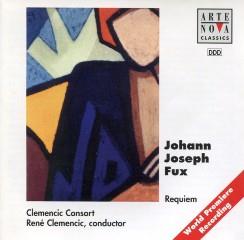Johann Joseph Fux - Missa Pro Defunctis 'Kaiserrequiem' (1995)
Johann Joseph Fux - Missa Pro Defunctis 'Kaiserrequiem' (1995)

1 Sonata A Tre Ex D Per Due Violini K 342 (Violoncello & Basso Continuo) Allegro – Grave – Presto – Grave – Presto 4:38 2 Ciaccona Per Organo K 403/2 4:52 3 Grave From Sonata A Tre Ex D K 342 (2 Trombones, Organ, Violone) 1:02 4 Media Vita In Morte Sumus (Chorale, After A Version Of The "Gross Catholisch Gesangbuch" Of David Gregor Corner, Nuremberg 1625) 1:18 5 De Profundis K 130, Motet 4:05 6 Adagio Per Organo K 400 From Sonata Terza 1:57 7 Requiem Aeternam "Kaiserrequiem" K 51 - 53: Kyrie Eleison 8:39 8 Requiem Aeternam "Kaiserrequiem" K 51 - 53: Dies Irae 13:21 9 Libera Me, Domino K 54, Motet 3:42 10 Largo From Canon A Due E 66 (2 Trombones, Organ, Violone) 1:00 11 Requiem Aeternam "Kaiserrequiem" K 51 - 53: Domine Jesu Christe 4:40 12 Requiem Aeternam "Kaiserrequiem" K 51 - 53: Sanctus 2:48 13 Adagio K 400 From Sonata Terza (2 Trombones, Organ, Violone) 1:07 14 Requiem Aeternam "Kaiserrequiem" K 51 - 53: Agnus Dei / Lux Aeterna / Requiem Aeternam 5:15 Alto Vocals – Stephanie Prewitt Baritone Vocals – Jörg-Steffen Duit, Thomas Schaller Bass Vocals – John Winbigler Cello – Dorothea Kukelka Organ [Positive] – Peter Widensky Soprano Vocals – Elizabeth Dobie, Pamela Mildenhall Tenor Vocals – James Curry Trombone – Ernst Hoffmann, Werner Hackl Viol [Violone] – Ulrich Fussenegger Viola – Herbert Lindsberger Violin [1st] – Hiro Kurosaki Violin [2nd] – Andrea Bischof Clemencic Consort René Clemencic - Conductor
The so-called Emperor's requiem (K 51 - 53) was composed by the Emperor's court Kapellmeister Fux on the occasion of the funeral rites of the Emperor's widow (the widow of Emperor Leopold I) which took place on 5th March 1720 in Vienna: Eleonore Magdalena (06/01/1655 in Dusseldorf - 19/01/1720 in Vienna), Empress, third wife of Emperor Leopold I.
Fux employes in this requiem an instrumentation in the contemporary term "stylus mixtus"- a group of instruments which excludes trumpets and timpani and the ceremonial aura they bring; he adapts his compositional style to the solemn occasion by limiting the orchestral writing and excluding lengthy orchestral passages. From the remarks on the cover of the instrumental parts to this requiem (which are in the possession of the Viennes Hofmusikkapelle) it can be seen that the work was further heard on 28th april 1729 at the requiem mass for Leopold Joseph of Lotheringen, the father of the later Emperor Franz I, on 12th July 1736 for Prince Eugen of Savoyen (a sign of the especial esteem in which the Prince was held) and on 16th November 1740 for Emperor Karl VI. According to the tradition in those days it was possible to offer on less important occasions not a complete performance of a requiem but a compilation of individual movements from varied works. The Emperor's requiem was for instance further performed in full on All Saint's Day in 1731, 1735, 1737, 1739, but in 1736 only in part. The first two movements were played on 10th October 1741 by the court orchestra to commemorate the death of Emperor Karl VI. The final performance noted on the cover inexplicably also in part took place for reasons still unknown on 13th August 1743. ---Thomas Hochradner, requiemsurvey.org
download (mp3 @320 kbs):
yandex mediafire uloz.to cloudmailru gett








